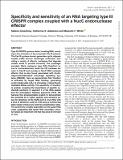Files in this item
Specificity and sensitivity of an RNA targeting type III CRISPR complex coupled with a NucC endonuclease effector
Item metadata
| dc.contributor.author | Grüschow, Sabine | |
| dc.contributor.author | Adamson, Catherine S. | |
| dc.contributor.author | White, Malcolm F. | |
| dc.date.accessioned | 2021-12-09T13:30:03Z | |
| dc.date.available | 2021-12-09T13:30:03Z | |
| dc.date.issued | 2021-12-16 | |
| dc.identifier | 276738516 | |
| dc.identifier | cb7e1020-b1a8-4f7e-a9e6-486f990c8fb1 | |
| dc.identifier | 85122843087 | |
| dc.identifier | 85122843087 | |
| dc.identifier | 34871408 | |
| dc.identifier.citation | Grüschow , S , Adamson , C S & White , M F 2021 , ' Specificity and sensitivity of an RNA targeting type III CRISPR complex coupled with a NucC endonuclease effector ' , Nucleic Acids Research , vol. 49 , no. 22 , gkab1190 , pp. 13122-13134 . https://doi.org/10.1093/nar/gkab1190 , https://doi.org/10.1093/nar/gkab1190 | en |
| dc.identifier.issn | 0305-1048 | |
| dc.identifier.other | ORCID: /0000-0003-1543-9342/work/104618625 | |
| dc.identifier.other | ORCID: /0000-0001-7673-5212/work/104618655 | |
| dc.identifier.uri | https://hdl.handle.net/10023/24496 | |
| dc.description | Funding: This work was supported by grants from the Biotechnology and Biological Sciences Research Council (Grant BB/T004789/1 to MFW), Medical Research Scotland (Grant CVG-1719-2020 to MFW) and The University of St Andrews Restarting Research Funding Scheme (SARRF), funded through the Scottish Funding Council (grant reference SFC/AN/08/020) to MFW and CSA. | en |
| dc.description.abstract | Type III CRISPR systems detect invading RNA, resulting in the activation of the enzymatic Cas10 subunit. The Cas10 cyclase domain generates cyclic oligoadenylate (cOA) second messenger molecules, activating a variety of effector nucleases that degrade nucleic acids to provide immunity. The prophage-encoded Vibrio metoecus type III-B (VmeCmr) locus is uncharacterised, lacks the HD nuclease domain in Cas10 and encodes a NucC DNA nuclease effector that is also found associated with Cyclic-oligonucleotide-based anti-phage signalling systems (CBASS). Here we demonstrate that VmeCmr is activated by target RNA binding, generating cyclic-triadenylate (cA3) to stimulate a robust NucC-mediated DNase activity. The specificity of VmeCmr is probed, revealing the importance of specific nucleotide positions in segment 1 of the RNA duplex and the protospacer flanking sequence (PFS). We harness this programmable system to demonstrate the potential for a highly specific and sensitive assay for detection of the SARS-CoV-2 virus RNA with a limit of detection (LoD) of 2 fM using a commercial plate reader without any extrinsic amplification step. The sensitivity is highly dependent on the guide RNA used, suggesting that target RNA secondary structure plays an important role that may also be relevant in vivo. | |
| dc.format.extent | 13 | |
| dc.format.extent | 3483429 | |
| dc.language.iso | eng | |
| dc.relation.ispartof | Nucleic Acids Research | en |
| dc.subject | Type III Crispr | en |
| dc.subject | NucC | en |
| dc.subject | Nuclease | en |
| dc.subject | RNA detection | en |
| dc.subject | SARS-CoV-2 | en |
| dc.subject | COVID-19 | en |
| dc.subject | QH301 Biology | en |
| dc.subject | QR355 Virology | en |
| dc.subject | Genetics | en |
| dc.subject | NDAS | en |
| dc.subject.lcc | QH301 | en |
| dc.subject.lcc | QR355 | en |
| dc.title | Specificity and sensitivity of an RNA targeting type III CRISPR complex coupled with a NucC endonuclease effector | en |
| dc.type | Journal article | en |
| dc.contributor.sponsor | Scottish Funding Council | en |
| dc.contributor.sponsor | BBSRC | en |
| dc.contributor.institution | University of St Andrews. School of Biology | en |
| dc.contributor.institution | University of St Andrews. Biomedical Sciences Research Complex | en |
| dc.contributor.institution | University of St Andrews. St Andrews Bioinformatics Unit | en |
| dc.identifier.doi | 10.1093/nar/gkab1190 | |
| dc.description.status | Peer reviewed | en |
| dc.identifier.grantnumber | N/A | en |
| dc.identifier.grantnumber | BB/T004789/1 | en |
This item appears in the following Collection(s)
Items in the St Andrews Research Repository are protected by copyright, with all rights reserved, unless otherwise indicated.

